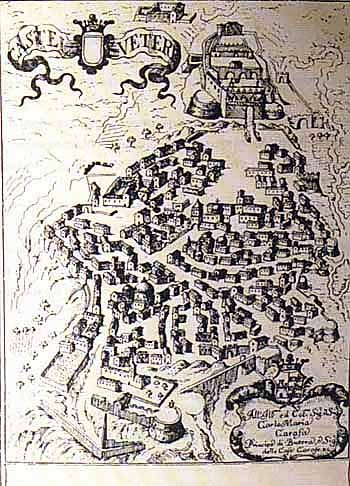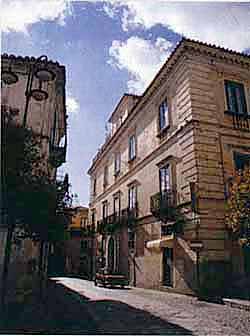|
Caulonia
by Gustavo Cannizzaro

Pacichelli print - 1703 |
By
the decree of the 26th of March 1863, Castelvetere
changed its name to Caulonia and the city began a new era of
its history. We were in post-Risorgimento Italy and our community
was preparing to live the problems and hopes that new times
would bring. This young kingdom through the works of T. Mommsem
and the poet G. Carducci the values and the charm of the classic
world. During the same years H. Schliemann, with his admirable
discoveries, gave a strong impetus to the archaeology which
was coming into its golden age. To tell the truth our people
have always been aware of their classical origins, reinforced
by the continual discovery of objects over the entire territory.
Over the course of centuries, as Prota tells us, the various
Barrio, Marafioti, Nicolosi and Alberti always remembered that
the inhabitants of the Greek colony built, on the high planes
of the valley of the amusa and of the Allaro, Castelvetere and
that the same Kaulon had to rise right after the banks of the
allaro river, near the site of Focŕ. Inspired by this knowledge
the Castelvetere citizens obtained the decree in 1863. Nearly
three decades were to pass before the archaeological investigation,
led by Paolo Orsi, established as a certainty that the original
site had been near Punta Stilo. During this time, not only did
the city change its name but also, in part, the internal toponomy
to introduce references to the new regents: the Mese became
Piazza Umberto I, Piazza Seggio became Piazza Vittorio Emanuele
II and the road which crosses the entire historical centre took
on the first queen of Italy’s name: Margherita.
Caulonia did not only
renew itself by changing its streets’ names, it also gave itself
a more modern urban facade. The roads were restudied, work was
begun on the new roads connecting, even today, the Marina to
the centre. The aqueduct was built which brought drinking water
to the inhabitants, the cemetary was built outside
the town on the foundations
of the ancient Cappuccini convent.Street lighting was put
in,in the shape of petrol
lamps. These were the years when thefirst transatlantic emigration
took place.

Via Vincenzo Niutta |
Since the beginning of
the century, the archpriest Davide Prota had finished his work
on the archives which he published in 1913 under the title:
Ricerche Storiche Su Caulonia. It has been amply used in the
creation of this guide. Our admiration and gratitude towards
this great man, who with his meticulousness managed to gather
a huge amount of information, is huge and enables us to have
a serious knowledge of our history. Without Prota’s work, we
would only have an extremely vague idea of our past.
Caulonia also gave the Great War its contribution in blood and
many of its inhabitants received merits and medals for valour
and the title of Cavalieri di Vittorio veneto.
The “ventennio” (20 years) passed Caulonia without strong social
contrasts. Not even political violence was common. The way forward
was taken by holding demonstrations and leading the same life
as usual. With the end of the Second World War, Caulonia witnesses
a strong social dynamism in the shape of the “Repubblica Rossa
di Caulonia” (the red republic of Caulonia) before and with
the subsequent land occupation. Lastly, the disastrous flooding
of 1951 was the origin of the great change caused by a strong
emigration flux and the birth of Caulonia Marina.
|






